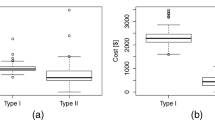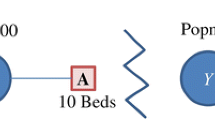Abstract
Health care planners in countries with a system based on a National Health Service (NHS) have to make decisions on where to locate and how to organize hospital services, so as to improve the geographic equity of access in the delivery of care while accounting for efficiency and cost issues. This study proposes a hierarchical multiservice mathematical programming model to inform decisions on the location and supply of hospital services, when the decision maker wants to maximize patients’ geographical access to a hospital network. The model considers the multiservice structure of hospital production (with hospitals producing inpatient care, emergency care and external consultations) and the costs associated with reorganizing the hospital network. Moreover, it considers the articulation between different hospital services and between hospital units, and the ascendant and descendent flows related to two-way referrals of patients in the hospital hierarchy. The proposed approach differs from previous literature by accounting simultaneously for these issues and provides crucial information for health care planners on referral networks, on hospital catchment areas, on the location and structure of hospital supply as well as on the costs required to improve access. The results from applying the model are illustrated in an application to the South region of the Portuguese NHS. Three scenarios are portrayed to describe how the model can be used in distinct institutional settings and policy contexts and when there is uncertainty concerning the key parameters of the model.
Similar content being viewed by others
Abbreviations
- DH:
-
District hospital
- CH:
-
Central hospital
- \({i\in I}\) :
-
Demand points
- \({j,l\in J}\) :
-
Potential locations for DH
- \({k\in K}\) :
-
Potential locations for CH
- \({w,v,a\in W}\) :
-
Hospital services (w = 1 for inpatient care, w = 2 for emergency service and w = 3 for external consultation)
- \({d_{ij}^{1}\, d_{ik}^2 }\) :
-
Travel time between a demand point iand a DH j/CH k
- \({d_{jk}^{3}}\) :
-
Travel time between DH j and CH k
- \({D_{i}^{w}}\) :
-
Demand for service w in demand point i
- DCwv :
-
Share of demand transferred from service w in a DH to service v in a CH
- CDwv :
-
Share of demand transferred from service v in a CH to service w in a DH
- p wv :
-
Share of demand transferred from service w to v within the same hospital
- adw acw :
-
Length of stay spent in service w in a DH/CH
- DHw CHw :
-
Maximum capacity allowed for service w operating in a DH and in a CH
- dhw chw :
-
Minimum capacity required for service w operating in a DH and in a CH
- α (0 ≤ α ≤ 1):
-
Weighting factor to differentiate first from second attendances (expressing planners’ preferences)
- β w(0 ≤ β w ≤ 1):
-
Weighting factor to differentiate hospital services (expressing planners’ preferences)
- pop j :
-
Population located in demand point j
- popmin :
-
Minimum population located in a demand point required to open a new hospital
- n :
-
Number of facilities to be opened
- stnd:
-
Maximum travelling time allowed for a population to access a hospital
- \({{\rm DHc}_j^w \,{\rm CHc}_k^w }\) :
-
Total unit costs for delivering care in a DH j and in a CH k
- DHec j DHic j :
-
Cost of expanding/investing one bed in an existing/new DH located in j
- \({{\rm icap}\_X_j^w }\) :
-
Current capacity of DH j
- TOC:
-
Total annual operating costs for all DHs
- TIC:
-
Total investment costs for all DHs
- \({X_j^w }\) :
-
Determines the opening (=1) or closure (=0) of a DH in location j that provides service w
- \({Y_k^w }\) :
-
Determining the opening (=1) or closure (=0) of a CH in location k that provides service w
- \({{\rm fd}_{ij}^w }\) :
-
Flow from population point i to DH j for service w
- \({{\rm fc}_{ik}^w }\) :
-
Flow from population point i to CH k for service w
- \({{\rm zdc}_{jk}^{wv}}\) :
-
Ascendant flow from service w in DHj to service v in CH k
- \({{\rm zcd}_{kj}^{wv}}\) :
-
Descendent flow from service w in CH k to service v in DH j
- \({{\rm td}_j^{wv}}\) :
-
Flow between service w and v inside DH j (auxiliary variable)
- \({{\rm tc}_k^{wv}}\) :
-
Flow between service w and v inside CH k (auxiliary variable)
- \({{\rm cap}\_X_j^w }\) :
-
Capacity for service w in a DH j
- \({{\rm cap}\_Y_k^w }\) :
-
Capacity for service w in a CH k
References
Algarve Health Region (2004) Plano Director Regional da Saúde do Algarve (Regional plan for health in Algarve). Faro
Culyer A (2001) Equity—some theory and its policy implications. J Med Ethics 27: 275–283
Current J, Min H, Schilling D (1990) Multiobjective analysis of facility location decisions. Eur J Oper Res 49(3): 295–307
Daskin M (1995) Network and discrete location. Wiley, New York
Daskin M (2008) What you should know about location modelling. Nav Res Logist 55: 283–294
Eiselt HA, Laporte G (1995) Objectives in location problems. Drezner Z (ed) Facility location—a survey of applications and methods Springer, New York, pp 151–180
Folland S, Goodman A, Stano M (1997) The economics of health and health care, 2nd edn. Prentice-Hall, Upper Saddle River
Galvão RD, Espejo A, Gonzalo L, Boffey B (2002) A hierarchical model for the location of perinatal facilities in the municipality of Rio de Janeiro. Eur J Oper Res 138(3): 495–517
Galvão RD, Acosta E, Luis G, Boffey B, Yates D (2006) Load balancing and capacity constraints in a hierarchical location model. Eur J Oper Res 172(2): 631–646
GAMS (2010) General algebraic modeling system version 23.6.5. Washington, DC, USA
Gerrard R, Church R (1996) Closest assignment constraints and location models: properties and structure. Locat Sci 4(4): 251–270
Health Ministry (1990) Lei no 48/90: Lei de Bases da Saúde (fundamental principles of health) Diário da Républica: I série, no 195 de 24 de Agosto
Health Ministry (2002) Rede de referenciação hospitalar em oncologia (hospital network in oncology). Lisbon
Health Ministry (2003) Centros de saúde e hospitais: recursos e produção do SNS (primary care centre and hospitals: production and resources of the NHS). Lisbon
Health Ministry (2006a) Reordenamento das capacidades hospitalares da cidade de Lisboa (redevelopment of hospital capacity in the city of Lisbon). Lisbon
Health Ministry (2006b) Contabilidade Analítica—Hospitais do SNS (cost accounting). Lisbon
Health Ministry (2007) Proposta da rede de urgências—Relatório Final (proposal of the emergency network—final report). Lisbon
Marianov V, Serra D (2004) Location problems in the public sector In: Drezner Z, Hamacher H (eds) Facility location: applications and theory. Springer, Berlin, pp 119–143
Marsh MT, Schilling DA (1994) Equity measurement in facility location analysis: a review and framework. Eur J Oper Res 74(1): 1–17
Mayhew LD, Leonardi G (1982) Equity, efficiency, and accessibility in urban and regional health-care systems. Environ Plan A 14(11): 1479–1507
McAllister DM (1976) Equity and efficiency in public facility location. Geogr Anal 8(1): 47–63
Melo MT, Nickel S, Saldanha-da-Gama F (2009) Facility location and supply chain management—a review. Eur J Oper Res 196(2): 401–412
Mestre A, Oliveira M, Barbosa-Póvoa A (2009) Aplicação do modelo hierárquico Multi-Serviço ao planeamento hospitalar na Região de Saúde do Norte (Application of the hierarchical multi-service model for hospital Planning in the Portuguese North Health Region). Internal report, Lisbon
Morgan G, Henrion M (1990) Uncertainty: a guide to dealing with uncertainty in quantitative risk and policy analysis. Cambridge University Press, New York
Narula SC (1986) Minisum hierarchical location-allocation problems on a network: a survey. Ann Oper Res 6: 257–272
Oliveira MD, Bevan G (2006) Modelling the redistribution of hospital supply to achieve equity taking account of patient’s behaviour. Health Care Manag Sci 9(1): 19–30
Oliveira MD, Pinto CG (2005) Health care reform in Portugal: an evaluation of the NHS experience. Health Econ 14(S1): S203–S220
Owen SH, Daskin MS (1998) Strategic facility location: A review. Eur J Oper Res 111(3): 423–447
Portuguese National Institute of Statistics (2006) XIV census. Accessed info service: http://www.ine.pt
Rahman S, Smith DK (2000) Use of location-allocation models in health service development planning in developing nations. Eur J Oper Res 123(3): 437–452
ReVelle CS, Eiselt HA (2005) Location analysis: a synthesis and survey. Eur J Oper Res 165(1): 1–19
Rice N, Smith P (2001) Capitation and risk adjustment in health care financing: an international progress report. Milbank Q 79(1): 81–113
Rosko MD, Broyles R (1988) The economics of health care: a reference handbook Greenwood Press, New York
Ruth RJ (1981) A mixed integer programming model for regional planning of a hospital inpatient service. Manag Sci 27(5): 521–533
Sahin G, Süral H (2007) A review of hierarchical facility location models. Comput Oper Res 34(8): 2310–2331
Salema M, Póvoa A, Novais A (2009) A strategic and tactical model for closed-loop supply chains. OR Spectr 31(3): 573–599
Savas ES (1978) Equity in providing public-services. Manag Sci 24(8): 800–808
Smith HK, Harper PR, Potts CN, Thyle A (2009a) Planning sustainable community health schemes in rural areas of developing countries. Eur J Oper Res 193(3): 768–777
Smith HK, Laporte G, Harper PR (2009b) Locational analysis: highlights of growth to maturity. J Oper Res Soc 60: 140–148
Smith H, Harper P, Potts C (2010) Bicriteria efficiency/equity hierarchical location models. Working paper, 152075. University of Southampton
Teixeira J, Antunes A, Peeters D (2007) An optimization-based study on the redeployment of a secondary school network. Environ Plan B 34(2): 296–315
Truelove M (1993) Measurement of spatial equity. Environ Plan C 11(1): 19–34
ViaMichelin Maps and route planner. http://www.viamichelin.co.uk. Accessed 2006
Author information
Authors and Affiliations
Corresponding author
Rights and permissions
About this article
Cite this article
Mestre, A.M., Oliveira, M.D. & Barbosa-Póvoa, A. Organizing hospitals into networks: a hierarchical and multiservice model to define location, supply and referrals in planned hospital systems. OR Spectrum 34, 319–348 (2012). https://doi.org/10.1007/s00291-011-0272-1
Published:
Issue Date:
DOI: https://doi.org/10.1007/s00291-011-0272-1




